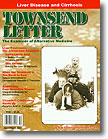


From the
Townsend Letter |
||
Dreaming and Anesthesia |
||
Dreaming
is a common and fascinating part of the anesthetic experience, but
it
remains a poorly understood phenomenon. Although other studies
have been done on this subject, few have assessed the relationship
between dreaming and depth of anesthesia, and their results were inconclusive.
The January issue of the journal Anesthesiology features a new Australian
study, "Dreaming during Anesthesia and Anesthetic Depth in Elective
Surgery." The study was conducted at three university hospitals
in Melbourne and Perth and documented that, not only do many patients
have dreams, but most of their dreams are pleasant or even prompted
by an overheard conversation while under anesthesia.
Of the 300 patients, nearly one-third (86) reported dreaming during
anesthesia in one or both of the interviews. At the first interview,
47 patients described having a dream, and at the second interview,
53 patients described having a dream. Of the 35 patients who reported
dreams at both interviews, 31 reported the same dream both times, and
four patients reported different dreams at each interview. There were
no clinically significant differences between dreamers and non-dreamers
in the monitor value used during anesthesia to measure the effects
of anesthetics and sedatives. For additional information on this study, go to: http://www.anesthesiology.org. |
||
![]()
Consult your doctor before using any of the treatments found within this site.
![]()
Subscriptions are available for Townsend Letter, the Examiner of Alternative Medicine magazine, which is published 10 times each year.
Search our pre-2001
archives for further information. Older issues of the printed magazine
are also indexed for your convenience.
1983-2001
indices ; recent indices
Once you find the magazines you'd like to order, please use our convenient form, e-mail subscriptions@townsendletter.com, or call 360.385.6021 (PST).
Who are we? | New
articles | Featured topics |
Tables of contents | Subscriptions | Contact
us | Links | Classifieds | Advertise | Alternative
Medicine Conference Calendar | Search site | Archives |
EDTA
Chelation Therapy | Home
© 1983-2007 Townsend Letter for Doctors & Patients
All rights reserved.
Website by Sandy Hershelman
Designs
December 2, 2007
![]()

